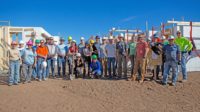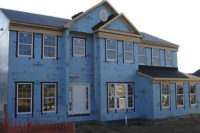With the addition of new materials like fiber cement board and composite panels joining traditional materials like wood and vinyl, stucco and plaster face stiffer competition than ever for market share in the siding industry. Stucco has always enjoyed the unique position of being able to bring Mediterranean architecture to life unlike any other siding material, which is why it remains an extremely popular siding material in California, Florida, the Southwest and other parts of the country today. In order to maintain its position over the years, the stucco industry has started to evolve with the advent of pre-blended stuccos to ensure consistent, high-quality results at a reasonable price.
That was followed by mobile mixing equipment and silo systems that make the use of pre-blended stucco even more attractive. To combat today’s ultra-competitive landscape, contractors are now turning to lightweight stucco as a differentiator that continues to make plaster a preferred siding material for individual and multi-family housing as well as hotels, hospitals, retail centers and other structures.
The Expectations
Before we explore the benefits of lightweight stucco, consider five specific expectations every contractor has of pre-blended stuccos.
- Quality: Pre-blended stuccos should be made of tested, certified, high-quality cement, lime, aggregate and other required ingredients.
- Consistency: Pre-blended stuccos should be mixed with automated technology in the proper amounts of each raw material every time.
- Jobsite Safety: Pre-blended stuccos should reduce labor fatigue and injuries associated with shoveling and mixing stucco ingredients on-site.
- Sustainability: Pre-blended stuccos should eliminate sand piles and run-off from the job sites that could be bad for the environment.
- Mobility: Pre-blended stuccos mixed in silos or other mobile equipment should be easy to relocate without loss of material or downtime.
The Reality
It is hard to imagine what else a contractor could possibly want in a pre-blended stucco material that meets all five of these criteria. Unless you consider that material is money, time is money, liability is money and callbacks are money. In that context, plastering with a stucco material that is 35 percent lighter, like the new QUIKRETE Lightweight Fiberglass Reinforced Stucco, is definitely an attractive siding option for contractors. First, it literally takes less material to cover the same wall area. Second, lightweight stucco makes it easier and faster to haul, unload, mix, lift, pump and spread, which translates into greater productivity with fewer fatigue induced mistakes or injuries. That’s less material used, time saved, liabilities prevented and callbacks avoided. Overall, lightweight stucco makes jobs more productive and profitable.
The obvious question is, “How do you make stucco lighter without jeopardizing strength and/or quality?” It’s actually fairly straightforward. About 50 percent of the heavy plaster sand in a bag of stucco is replaced with an equal volume of much lighter Expanded Polystyrene beads, which are recycled synthetic particles encapsulated in an applied coating. The coating makes the lightweight stucco static-free so it mixes easily, uniformly and bonds extremely well, while the alkali-resistant glass fibers in the mix provide the equivalent or better flexibility, durability and strength of traditional or pre-blended stuccos. The 35 percent lighter-cured weight also minimizes settlement cracks and reduces strain on fastening systems, which could lead to costly callbacks.
An added benefit of lightweight stucco is the ease at which it pumps, which has been put to the test by veteran stucco and EIFS contractor Dan Carrillo using Graco’s S340e pump. He found the lightweight stucco more than met his strenuous installation standards.
“The 50-pound bags made the job easier for the labor, the pumping equipment and the plasterer on the wall, and the material was also very easy to drag on the wall with a darby or a feather-edge rod,” says Carrillo. “Additionally, we witnessed no shrinkage cracks on the wall to date, which is a common occurrence with many pre-blended stucco products.”
Carrillo adds, “Our 120v pump is designed to pump fibered stucco basecoats through 100 feet of one and half inch hose with a typical browning nozzle. I brought 150 feet of hose to reach the entire project. Typically, it requires 300 psi of our rated 600 psi to pump stucco basecoats. The QUIKRETE Lightweight FRS material only created 80 psi (measured at the pump outlet) back pressure, while pumping full speed at the rate of one pallet (42 bags) per hour, so it exceeded expectations.”
Of course, if you’re using a lightweight stucco material make sure it meets all building codes and addresses Continuous Insulation challenges presented by Energy Code requirements. In some cases, contractors get the benefit of a one-hour fire rating, freeze-thaw durability, water resistance and U.S. Green Building Council LEED credits in a one-coat pass or in a conventional three-coat scratch and brown system.
The Summary
Working with lighter stucco decreases fatigue, increases speed and prevents mistakes improving overall productivity on jobs. Combined with unmatched durability, flexibility, workability, coverage area and ease-of-application, using lightweight stucco will keep jobs on time and in budget with minimal callbacks. Lightweight stucco is truly a revolutionary, game-changing product that will keep plasterers on walls for years to come.








Report Abusive Comment